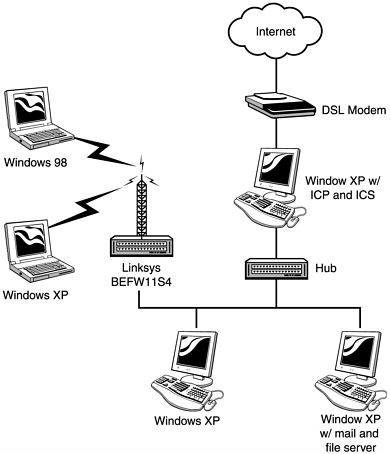The Test Network
| Because many WLANs are installed in small office or home office environments, our test WLAN will be designed with this topology in mind. Although a hacker or auditor would not be privy to the hardware and software configurations of the WLAN and internal LAN, we will provide you with a description of the particulars of our test network. Our WLAN uses a single Linksys BEFW11S4 access point that is connected to the hub of an internal LAN. The hub also connects three other devices, all running Windows XP, with one computer acting as a file/mail server for the rest of the network. The wireless network is protected using WEP, with a password of " games ," and the internal network is protected from Internet threats via a Windows XP PC running the Internet Connection Firewall. Internet service is provided via a DSL connection, which is shared out to the rest of the network via Internet Connection Sharing. Figure 11.1 is a graphical representation of our test network. Figure 11.1. Test network topology. Note the use of the integrated firewall to "protect" the network from outside intruders. You should also note that hacking a network that uses a WLAN will often take the form of two separate hack attacks. The first is to penetrate the WLAN's perimeter, and the second is to penetrate the wired network. Because we have written about wired network hacking in nauseating detail in our other books, we will mention it only briefly here, focusing instead on the wireless aspects of the attack. |
EAN: 2147483647
Pages: 171
